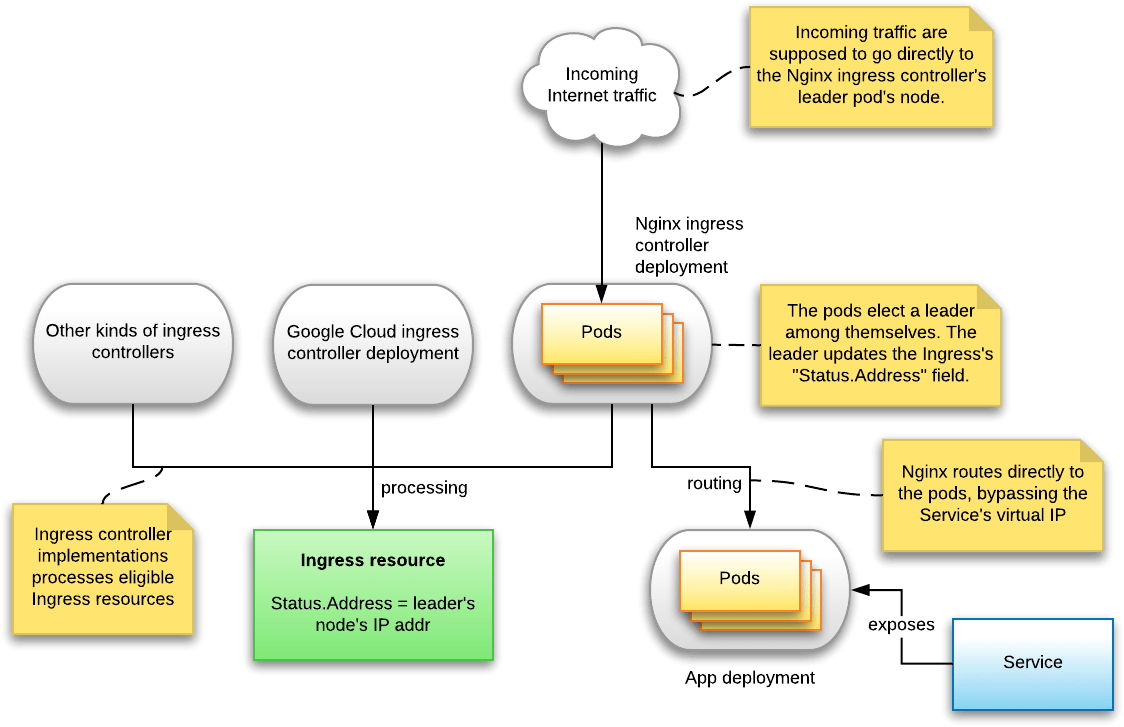Kubernetes/Ingress controller
The Ingress resource type was introduced in Kubernetes version 1.1. The Kubernetes cluster must have an Ingress controller deployed in order for you to be able to create Ingress resources. What is the Ingress controller? The Ingress controller is deployed as a Docker container on top of Kubernetes. Its Docker image contains a load balancer like nginx or HAProxy and a controller daemon. The controller daemon receives the desired Ingress configuration from Kubernetes. It generates an nginx or HAProxy configuration file and restarts the load balancer process for changes to take effect. In other words, Ingress controller is a load balancer managed by Kubernetes.
Ingress resources don't do anything by themselves: they are processed by ingress controllers, which vanilla Kubernetes does not provide by default.
- Ingress vs Loadbalancer service
The difference between the LoadBalancer service and the Ingress in how the traffic routing is realized. In the case of the LoadBalancer service, the traffic that enters through the external load balancer is forwarded to the kube-proxy that in turn forwards the traffic to the selected pods. The Ingress load balancer forwards the traffic straight to the selected pods which is more efficient.
Ingress object
Example below has been fetched from Minikube
stern nginx --all-namespaces nginx
kube-system ingress-nginx-controller-xx controller ------------------------------------------------------------ kube-system ingress-nginx-controller-xx controller NGINX Ingress controller kube-system ingress-nginx-controller-xx controller Release: 0.32.0 kube-system ingress-nginx-controller-xx controller Build: git-446845114 kube-system ingress-nginx-controller-xx controller Repository: https://github.com/kubernetes/ingress-nginx kube-system ingress-nginx-controller-xx controller nginx version: nginx/1.17.10 kube-system ingress-nginx-controller-xx controller ------------------------------------------------------------
$ kubectl get ingresses ingress-with-auth -oyaml
apiVersion: extensions/v1beta1
kind: Ingress
metadata:
annotations:
kubernetes.io/ingress.class: nginx # useful annotation
nginx.ingress.kubernetes.io/auth-realm: Authentication Required - foo
nginx.ingress.kubernetes.io/auth-secret: basic-auth
nginx.ingress.kubernetes.io/auth-type: basic
name: ingress-with-auth
namespace: default
spec:
# backend: # <Object> default backend
serviceName: # <string>
servicePort: # <string>
rules: # <[]object> list of host rules, if not specified sent to default backend
- host: echo-1.ingress.k8s.acme.cloud # fqdn of a network host, IPs are not allowed
http: # `:` is not respected because ports are not allowed
paths: # currently the port of an Ingress is http:80 and :443 for https
- backend:
serviceName: http-svc
servicePort: 80
path: /
# tls: # <[]Object> TLS configuration, currently supports a single TLS port:443
# - secretName: tls-certificate # secret used to terminate SSL traffic on 443
# hosts: # optional rules.host is used if unspecified; must match names in tlsSecret
# - echo-1.ingress.k8s.acme.cloud
status:
loadBalancer:
ingress:
- ip: 172.17.0.2 # Kubernetes API server IP
# public IP address on which this Ingress is available
# this is nginx-controller pod (leader) node IP
Status.Address update is a background goroutine that runs once a minute, queries the IP address of the node on which the Nginx ingress controller is running, and simply updates the Status.Address to that value.
Simple /etc/hosts entry will make your local machine to access an application exposed via Ingress
172.17.0.2 echo-1.ingress.k8s.acme.cloud
Interesting fact is that the ingress IP is actually the leader pod node's ip
$ kubectl get nodes -owide
NAME STATUS ROLES AGE VERSION INTERNAL-IP EXTERNAL-IP OS-IMAGE KERNEL-VERSION CONTAINER-RUNTIME
minikube-v1.15 Ready master 172m v1.15.11 172.17.0.2 <none> Ubuntu 19.10 5.3.0-59-generic docker://19.3.2
$ minikube ssh # ssh to Kubernetes node
docker@minikube-v1:~$ ip a | grep "inet "
inet 127.0.0.1/8 scope host lo
inet 172.18.0.1/16 brd 172.18.255.255 scope global docker0
inet 172.17.0.2/16 brd 172.17.255.255 scope global eth0 # <- K8s node ip
The ingress-nginx-controller pod exclusively binds to listen on ports :80 and :443 on the node is running
# $ minikube addons enable ingress # Running
$ sudo ss -lntp | tail +1 | sort -k4
State Recv-Q Send-Q Local Address:Port Peer Address:Port
LISTEN 0 128 *:10250 *:* users:(("kubelet",pid=5342,fd=28))
LISTEN 0 128 *:10251 *:* users:(("kube-scheduler",pid=6070,fd=3))
LISTEN 0 128 *:10252 *:* users:(("kube-controller",pid=6023,fd=3))
LISTEN 0 128 *:10256 *:* users:(("kube-proxy",pid=6679,fd=10))
LISTEN 0 128 *:2376 *:* users:(("dockerd",pid=88,fd=6))
LISTEN 0 128 *:30012 *:* users:(("kube-proxy",pid=6679,fd=14))
LISTEN 0 128 *:30932 *:* users:(("kube-proxy",pid=6679,fd=13))
LISTEN 0 128 *:32392 *:* users:(("kube-proxy",pid=6679,fd=11))
LISTEN 0 128 # -> *:443 *:* users:(("docker-proxy",pid=8486,fd=4)) # <- added by nginx-controller
LISTEN 0 128 # -> *:80 *:* users:(("docker-proxy",pid=8505,fd=4)) # <- added by nginx-controller
LISTEN 0 128 *:8443 *:* users:(("kube-apiserver",pid=5917,fd=3))
LISTEN 0 128 [::]:111 [::]:* users:(("rpcbind",pid=77,fd=6),("systemd",pid=1,fd=47))
LISTEN 0 128 [::]:22 [::]:* users:(("sshd",pid=89,fd=4))
LISTEN 0 128 [::]:37289 [::]:* users:(("rpc.statd",pid=3050,fd=11))
LISTEN 0 128 0.0.0.0:111 0.0.0.0:* users:(("rpcbind",pid=77,fd=4),("systemd",pid=1,fd=45))
LISTEN 0 128 0.0.0.0:22 0.0.0.0:* users:(("sshd",pid=89,fd=3))
LISTEN 0 128 0.0.0.0:39729 0.0.0.0:* users:(("rpc.statd",pid=3050,fd=9))
LISTEN 0 128 127.0.0.1:10248 0.0.0.0:* users:(("kubelet",pid=5342,fd=21))
LISTEN 0 128 127.0.0.1:10257 0.0.0.0:* users:(("kube-controller",pid=6023,fd=5))
LISTEN 0 128 127.0.0.1:10259 0.0.0.0:* users:(("kube-scheduler",pid=6070,fd=5))
LISTEN 0 128 127.0.0.1:2379 0.0.0.0:* users:(("etcd",pid=5867,fd=5))
LISTEN 0 128 127.0.0.1:2381 0.0.0.0:* users:(("etcd",pid=5867,fd=10))
LISTEN 0 128 127.0.0.1:38999 0.0.0.0:* users:(("kubelet",pid=5342,fd=9))
LISTEN 0 128 127.0.0.1:40073 0.0.0.0:* users:(("containerd",pid=87,fd=8))
LISTEN 0 128 172.17.0.2:10249 0.0.0.0:* users:(("kube-proxy",pid=6679,fd=12))
LISTEN 0 128 172.17.0.2:2379 0.0.0.0:* users:(("etcd",pid=5867,fd=6))
LISTEN 0 128 172.17.0.2:2380 0.0.0.0:* users:(("etcd",pid=5867,fd=3))
LISTEN 0 128 172.17.0.2:2381 0.0.0.0:* users:(("etcd",pid=5867,fd=12))
Nginx ingress controller
- Events changes watch
Nginx controller listens for events on the following resource types changes:
- Ingresses
- Endpoints
- Secrets
- ConfigMaps
Events get into the queue represented by controller.syncQueue and the internal/ingress/controller/controller.go queue handler function, function syncIngress(). This function collects all necessary information to regenerate the Nginx config file: it fetches all relevant Ingress objects and looks up associated Pods' IP addresses that the Ingresses should route to.
- Build new configuration and reload
syncIngress() then calls internal/ingress/controller/nginx.go function OnUpdate() to actually write out the new Nginx config file and to reload Nginx.
- Ingress
Status.Addressdetermination
A background goroutine which, once a minute, queries the IP address of the node on which the Nginx ingress controller is running, and simply updates the "Status.Address" to that value. With multiple controller pods running, the leader's IP is used.
- Not using Services
ingress-nginx-controller does not route traffic to the associated Service's virtual IP address. Instead it routes directly to the pods' IP addresses, using the endpoints API Resources. This allows for session affinity, custom load balancing algorithms, less overhead, such as conntrack entries for iptables DNAT.
- Resources
Resources
- Kubernetes Ingress Explained For Beginners by KodeKloud
